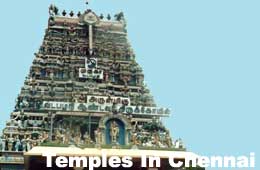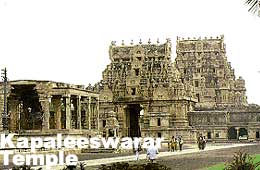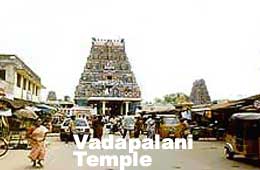| India Profile » Monuments and Temples in India » Temples of Chennai | |
Temples of Chennai | |
 | |
 The Cholas in the east, Pandyas in the central area and Cheras in the west controlled the region of Chennai during the last centuries Before Christ. This was also the classical period of Tamil literature, the Sangam Age, which continued for some three centuries after the birth of Christ. The Tamil Sangam Literature is the major source of knowledge about the administration, art, architecture and economic conditions of the Tamilians during that period. The domains of these dynasties changed many times over the centuries. The Pallava dynasty was influential particularly in the 7th and 8th centuries when it constructed many monuments at Mamallapuram. The threats of Muslim invasions from the north in the 13th century AD made the southern Hindu dynasties to combine and the empire of Vijayanagar, which incorporated all of South India, became firmly established. In the 16th century AD, the Vijayanagar Empire began to weaken up. By the 17th century AD, Southern India was ruled by various provincial leaders, most notable among them were the Nayaks, who continued the process of construction of monumental architecture. In 1640 AD, the British negotiated the use of Chennaipattinam (now Chennai) as a trading post. Chennaipattinam was a very popular trading center for spices and clothes for more than 2000 years. The Portuguese and the Dutch arrived here in the 16th century AD followed by the British and the French. In 1639 AD, the British East India Company established a settlement in the fishing village of Madraspattnam leased from the local Nayaks. They started construction of the Fort St. George in Madraspattnam. George Town grew in the area of fort and neighboring villages and ultimately became the oldest Municipality of India in 1668 AD. Gradually, the city grew into modern city of Madras merging all neighboring areas. In the 19th century the city became the seat of Madras Presidency, the southern division of British Imperial India. In 1956, the Chennai Presidency was disbanded. After independence in 1947, it became the capital of Madras State that was renamed Tamil Nadu. Madras was renamed Chennai recently. The temples of Chennai are the peepholes into the splendor of culture, religion and architecture of Tamil state. The Chola and Pallava art and architecture dominates the skyline of the entire state. The Chola kings of the 9th century AD built temples of modest height in granite. Special attention was paid to the sanctum sanctorum where deities were placed in niches as prescribed in the ritual treatises. Rajaraja Chola constructed the most grandiose of the south Indian temples, 85 m in height, which is a marvel of symmetry and structural design. 5 m high dwarapalas (guardians) stand at the entrance. From the 16th century AD, the gopurams (entrance towers) under the Vijayanagar King Krishna Devaraya spiraled to greater heights as much as 60 m. They came to be known as rayagopuras (royal towers) after his name. The bases of these towers were built of stone and the entire superstructure was of brick and mortar, painted and studded with hundreds of stucco figures.  Sri Kapaleeswarar Temple The Kapaleeswarar temple is situated near Kutchery Road, Mylapore. It is an ancient temple dedicated to Lord Shiva. It is a fine example of Dravidian temple architecture and sculpture. The gopuram of the temple is 37 m tall magnificent structure, which is one of the main attractions of this temple. There is a massive rectangular step well in front of its gopuram. Non-Hindus are not allowed to enter the inner courtyard of the temple. The outer courtyard has several bronze statues. Parthasarathy Temple Parthasarathy temple is situated at Peter's Road, Triplicane. It is one of the oldest temples in Chennai. It was originally built by Pallavas in the 8th century AD and rebuilt by the Chola and the Vijayanagar Kings in 11th century. The temple is dedicated to Krishna, the eighth incarnations of the Vishnu. It has a colored gopuram and several shrines with beautiful carvings. Kandaswamy Temple The Kandaswamy temple is situated at Cheyur at Madurantakam near Chennai. It is an ancient temple and can be dated back to the 11th century AD. There is another famous temple in Madurantakam dedicated to Eri Katta Ramar. Madurantakam is well known for its temple to Eri Katta Ramar. There are two other ancient temples in Cheyur dedicated to Perumaal and Shiva Valmimakathar both dating back to the Chola period. The Shiva temple is rich in inscriptions.  Vadapalani Temple Vadapalani temple is dedicated to Lord Muruga. It is most revered deity of the people of Tamil as the Lord of Tamil. There is a sanctum for Lord Shiva, his consort Parvati and their son Ganesha. Lord Anjaneya is also a popular deity of the temple. Devotees apply butter to Lord Anjaneya and pray for the fulfillment of their wishes. The three devout Murugan bhaktas played an important role in the popularity of the temple. It houses several mini-shrines for the highest divinities, like Mahalakshmi, Meenakshi, Valli Devasena, Sametha Subrahmanya, Chandikeswar, Dakshinamurthi, Bhairava, Chokkanathar etc. The other places around the city of Chennai known for temples are Kanchipuram, which is 75 km from and Mamallapuram, which is 58 km from Chennai. Kancheepuram has several temples unique in their own way. Kanchipuram is called the Golden City of temples. It is famous for saris woven out of pure silk and gold thread for more than four centuries. It is a famous centre of culture and learning. Adi Shankaracharya has established his ashram, Kamakoti Peetam here. Mamallapuram was built in the 7th century AD. The Shore temple is a spectacular two-spired shrine and houses shrines for Vishnu and Shiva. The Pallavas had perfected the art of sculpting rocks to build temples without using brick, mortar or timber. The five monolith Raths (chariots) stand as the surviving masterpieces of Pallava sculpture. |
|
 |